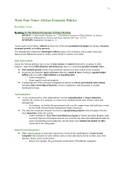Summary
Economy: Africa Readings summary of week 4: African Economic Policies + lecture notes
- Course
- Institution
T.J. Moss and D. Resnick, ch. 7 “The Political Economy of Policy Reform” in African Development: Making Sense of Issues and Actors, Rienner (2017) pp. 113-129. A. El-Sayed El-Naggar, ch. 2 “Economic policy: from state control to decay and corruption”, in Egypt: The Moment of Change, R. ...
[Show more]



